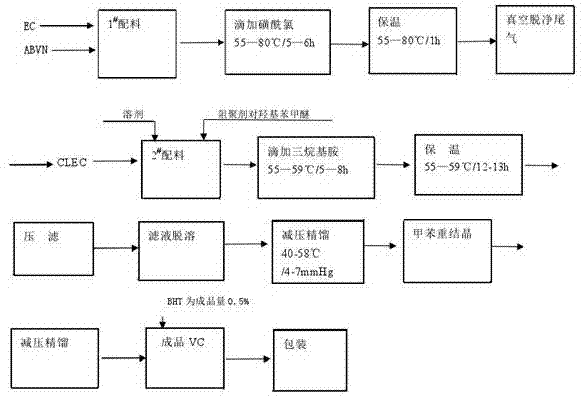Vinylene carbonate preparation method
The technology of vinylene carbonate and ethylene carbonate is applied in the field of preparation of vinylene carbonate, which can solve the problems of high equipment and process requirements, and achieve the effects of good economic and social benefits, simple process flow and strong operability.
- Summary
- Abstract
- Description
- Claims
- Application Information
AI Technical Summary
Problems solved by technology
Method used
Image
Examples
preparation example Construction
[0023] A kind of preparation method of vinylene carbonate, it comprises the following steps:
[0024] (1) Synthesis of monochloroethylene carbonate (ClEC): using ethylene carbonate (EC) as raw material, azo compound as initiator, and sulfonyl chloride as chlorinating agent, free radical substitution reaction occurs to obtain monochlorocarbonic acid Vinyl esters (ClEC).
[0025] The main reaction equation is:
[0026]
[0027] Specifically: Add ethylene carbonate (EC) into the reactor, add azo compounds according to the oil-soluble initiator azo compound: EC=2-3:100 (weight ratio), and the molar ratio of sulfuryl chloride and EC is 1.1 -1.2:1 Add sulfuryl chloride dropwise, the dropwise addition temperature is 55~80°C, the dropwise addition time is 5~6 h, and then keep warm for 1 h, and the tail gas is removed in vacuum to obtain the crude ClEC.
[0028] (2) In the presence of dimethyl carbonate (DMC), bimolecular elimination reaction (E-2 reaction process) occurs between ...
Embodiment 1
[0043] Example 1: Press figure 1 The steps shown: (1) Add 500 kg (5.68 kmol) of ethylene carbonate (EC) to the chlorination kettle, raise the temperature to 70~80 ℃ and add 13 kg of azobisisobutyronitrile (AIBN) (2.6% of the amount of EC) , and at 70~80 ℃, 843 kg (6.25 kmol) of sulfuryl chloride was added dropwise within 4.5~6 hours, and at the same time, 1.3 kg of AIBN was added every 30 minutes, and AIBN was added 10 times in total. Insulate at 80°C for 1 h, remove the tail gas in vacuum, and cool down to obtain 668 kg (about 5.45 kmol) of crude monochloroethylene carbonate. The conversion rate from EC to ClEC is 91%. (2) Add 668 kg of the ClEC crude product obtained in step (1), 2000 kg of dimethyl carbonate, and 3.3 kg of the polymerization inhibitor p-hydroxyanisole to the dehydrochlorination kettle. Raise the temperature to 55-59 °C, add 668 kg (6.6 kmol) of triethylamine dropwise in 5-8 h, and keep the temperature for 12 h after the dropping. A mixture containing vin...
Embodiment 2
[0044] Example 2: Press figure 1 Shown: Step (1) Add 500 kg (5.68 kmol) of ethylene carbonate (EC) to the chlorination tank and heat up to 55~60 °C, then add 12.5 kg of azobisisoheptanonitrile (ABVN) at one time, and At ~60°C, 882 kg (6.53kmol) of sulfuryl chloride was added dropwise within 4~5 hours. After the drop was completed, the temperature was kept at 55~60°C for 1 hour, the tail gas was removed in vacuum, and the crude product of chloroethylene carbonate (ClEC) 675 kg (about 5.51 kmol). The conversion rate from EC to ClEC is 96.3%. GC analysis contained EC 3.7 %, ClEC 87.3 %, dichloroethylene carbonate Cl 2 EC 6.3%, undetected substance 2.7%. Step (2) Add 675 kg of crude ClEC obtained in step (1) to the dehydrochlorination kettle, add 2025 kg of dimethyl carbonate, and 3.4 kg of p-hydroxyanisole as a polymerization inhibitor. 675 kg (6.68 kmol) of triethylamine was added dropwise within 5-8 h, and after the drop was completed and kept for 12 h, a mixture containing...
PUM
 Login to View More
Login to View More Abstract
Description
Claims
Application Information
 Login to View More
Login to View More - R&D
- Intellectual Property
- Life Sciences
- Materials
- Tech Scout
- Unparalleled Data Quality
- Higher Quality Content
- 60% Fewer Hallucinations
Browse by: Latest US Patents, China's latest patents, Technical Efficacy Thesaurus, Application Domain, Technology Topic, Popular Technical Reports.
© 2025 PatSnap. All rights reserved.Legal|Privacy policy|Modern Slavery Act Transparency Statement|Sitemap|About US| Contact US: help@patsnap.com



